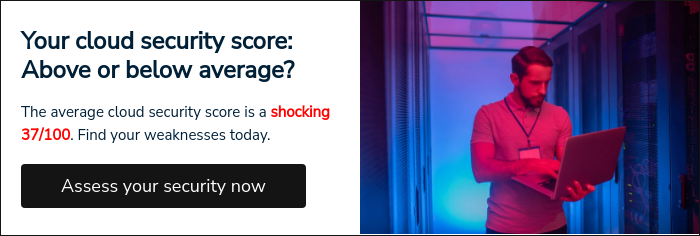What is cloud security?

Cloud computing has become essential for organizations to innovate and streamline operations. However, with the increasing reliance on the cloud, securing data and systems has become paramount.
Cloud security encompasses a set of measures and technologies designed to protect cloud-based infrastructure, applications, and data from cyber threats. Safeguarding sensitive information from unauthorized access is a critical aspect of cloud security, especially with the risks associated with storing data online and utilizing cloud services.
Cloud security plays a pivotal role in ensuring the confidentiality, integrity, and availability of data in cloud environments. As cyber threats evolve, so do the strategies and technologies used to combat them. Cloud security solutions leverage cutting-edge tools like artificial intelligence and machine learning to proactively identify and mitigate potential risks.

Robust cloud security is essential for several reasons:
- Data protection: Effective cloud security safeguards sensitive data from breaches, loss, and other threats, maintaining the trust of customers, partners, and employees.
- Business continuity: By protecting cloud infrastructure and services, cloud security ensures continuous operations, minimizing downtime and financial losses.
- Risk mitigation: Cloud security helps organizations identify and address vulnerabilities, reducing the likelihood of successful cyber attacks.
- Compliance: Many industries have stringent regulatory requirements for data protection, and cloud security ensures that organizations adhere to these standards.
While cloud computing offers immense benefits, it's important to acknowledge the potential risks involved. By implementing comprehensive cloud security measures, organizations can reap the rewards of cloud technology while minimizing potential drawbacks. Cloud security strategies encompass securing data both in transit and at rest, implementing robust access controls, and continuously monitoring for potential threats.
Investing in cloud security is not only a matter of protecting data; it's about safeguarding the trust that underpins successful business operations. Organizations that prioritize cloud security demonstrate their commitment to protecting sensitive information and ensuring the reliability of their cloud services.

Definition of cloud security
Cloud computing security, also known as cloud security, is the practice of safeguarding data, applications, and infrastructure within cloud environments. It encompasses a wide range of measures designed to protect against various threats, including unauthorized access, data breaches, and cyberattacks.
A critical component of cloud security is cloud security posture management (CSPM), which focuses on identifying and mitigating risks to maintain the security integrity of cloud resources. CSPM helps ensure that physical servers, data centers, and software applications operating within the cloud are adequately protected.
Cloud security is a multifaceted field, encompassing data encryption, compliance with industry regulations, and secure software development practices. It's essential for safeguarding sensitive data from unauthorized access, preventing data loss, and minimizing the risks associated with storing and processing information online.
As cyber threats continue to evolve, cloud security must adapt as well. Advanced technologies like artificial intelligence and machine learning play an increasingly important role in proactively detecting and responding to potential threats.
Investing in robust cloud security measures is crucial for organizations of all sizes. It not only protects valuable data assets but also maintains customer trust and ensures the continuity of critical business operations. By prioritizing cloud security, organizations can confidently leverage the benefits of cloud computing while minimizing potential risks.
Why cloud security matters
Cloud security is essential for every organization leveraging cloud computing. It safeguards sensitive data and maintains the trust of stakeholders, including customers, partners, and employees.
The interconnected nature of the cloud means that a security breach can have far-reaching consequences. Organizations could face the exposure of large volumes of sensitive data, operational disruptions, and financial losses. Effective cloud security measures mitigate these risks by protecting data both in transit and at rest, along with implementing strict access controls.

Beyond data protection, cloud security ensures the availability and reliability of critical services. Many organizations rely on cloud infrastructure for various operations, making any disruption a potential source of inefficiency and productivity loss. Robust cloud security includes measures to defend against cyberattacks, as well as disaster recovery and business continuity planning. These components are vital for maintaining business operations in the event of security incidents or other disruptions.
In summary, cloud security is a fundamental requirement for organizations operating in the cloud. It protects sensitive data, maintains stakeholder trust, ensures the availability and reliability of services, and mitigates the risks of operational disruptions. Investing in robust cloud security measures is a strategic decision that safeguards an organization's assets and reputation.

How does cloud security work?
Cloud security operates through a shared responsibility model between the cloud provider and the customer. Each party plays a crucial role in maintaining a secure cloud environment.
Cloud provider responsibilities:
- Physical security: Providers are responsible for securing physical infrastructure, including data centers, servers, and network equipment. This involves implementing measures like access controls, video surveillance, and environmental monitoring.
- Network security: Providers manage network security, including firewalls, intrusion detection systems (IDS), and regular security audits to protect the underlying infrastructure.
- Hypervisor security: Providers secure the hypervisor layer, which is the software that creates and manages virtual machines, ensuring the isolation of different virtual environments.
Customer responsibilities:
- Application security: Customers are responsible for securing the applications they deploy in the cloud. This includes implementing secure coding practices, conducting vulnerability assessments, and patching software regularly.
- Data security: Customers must protect their data in the cloud by managing encryption keys, configuring privacy settings, and controlling user permissions.
- Endpoint security: Customers should employ security tools like antivirus software, application security testing, and endpoint protection solutions to safeguard devices accessing cloud resources.
This shared responsibility model creates a multi-layered defense-in-depth strategy that addresses security concerns across the entire cloud stack. This multifaceted approach is essential for protecting against the evolving landscape of cyber threats.
Cloud security challenges:
While cloud security offers significant benefits, several challenges must be addressed:
- Visibility and control: Organizations may face challenges in maintaining visibility and control over their data and applications in the cloud. Implementing effective security controls can help manage access and protect sensitive information.
- Misconfigurations and multitenancy: Misconfigurations of cloud resources can create vulnerabilities, and multitenancy environments, where multiple customers share resources, pose unique security challenges. Proper configuration and access management are crucial to mitigate these risks.
- Access control: Managing access to cloud resources is critical. Organizations need to implement robust identity and access management (IAM) solutions to ensure that only authorized users can access sensitive data and applications.
- Shadow IT: The unauthorized use of cloud services by employees (shadow IT) can introduce security risks. Organizations must establish clear policies and procedures for cloud usage to maintain control.
- Regulatory compliance: Adhering to various industry regulations and data protection laws can be complex. Cloud security solutions should help organizations meet these compliance requirements.
Addressing these challenges is paramount to ensure the protection of sensitive data, maintain the resilience of cloud operations, and safeguard against the ever-growing cyber threats targeting cloud environments. Let’s dive more into these challenges.
What are some cloud security challenges?
Cloud security presents several challenges due to the unique characteristics of cloud technology and the complexity of securing distributed environments:

Limited visibility
Gaining comprehensive visibility into data storage and access paths within cloud environments can be difficult. This limited visibility makes it harder to detect unauthorized activities and respond to security threats promptly. Organizations can mitigate this challenge by implementing advanced monitoring tools and Security Information and Event Management (SIEM) systems that provide insights into data flows and potential vulnerabilities. Training IT teams to effectively utilize these insights can further enhance threat detection and mitigation capabilities.
Misconfigurations
The dynamic and complex nature of cloud technologies makes misconfigurations a common issue. Organizations can address this by automating configurations and using configuration management tools to conduct regular audits. This ensures that security settings are consistently applied and maintained according to best practices, minimizing the risk of human error and enhancing overall security.
Multitenancy
Multitenant cloud environments, where multiple users share infrastructure, can expose organizations to data leakage risks if segregation controls are inadequate. Strong isolation mechanisms are crucial for ensuring data integrity and preventing breaches from shared resources. Organizations should conduct continuous security assessments to verify the effectiveness of tenant isolation and protect against potential vulnerabilities arising from shared resources.

Access management and shadow IT
Managing access to cloud resources and controlling shadow IT (the unauthorized use of cloud services) are significant challenges. Organizations can address this by enforcing strict IT governance policies, utilizing Cloud Access Security Brokers (CASBs) to monitor and control unsanctioned service usage, and conducting regular audits to ensure that access privileges align with organizational security policies.
Compliance
Adhering to industry regulations in a cloud environment can be complex due to the shared responsibility model and the dynamic nature of cloud services. Organizations should leverage compliance management software to understand and implement compliance requirements effectively. Regular audits and consultation with legal advisors can help navigate the complexities of cloud compliance and ensure adherence to legal and regulatory frameworks.
By proactively addressing these challenges and implementing robust security measures, organizations can effectively mitigate risks, protect their data, and maintain the integrity and resilience of their cloud operations.
Cloud security benefits
Cloud security offers numerous benefits that empower organizations to safeguard their digital assets, enhance their security posture, and build trust with users in the increasingly complex cloud computing landscape.
Enhanced visibility
Cloud security solutions provide greater visibility into security operations across an organization's entire digital landscape. This heightened visibility enables administrators to monitor cloud services effectively, detect suspicious activities promptly through detailed activity logs and comprehensive monitoring tools, and quickly mitigate potential threats.

Centralized security management
Centralizing security management simplifies the oversight of diverse and often unrelated systems and applications. It ensures that consistent security policies and practices are applied across all digital assets, improving the effectiveness of protective measures and response strategies. This streamlines security operations and creates a unified security posture across the entire organization.
Reduced costs
Cloud security can lead to significant cost savings in security management. By leveraging economies of scale and shared services offered by cloud providers, organizations can benefit from advanced security infrastructure and expertise without the substantial upfront investments and ongoing maintenance costs associated with in-house security operations. This reduces capital expenditures and operational costs, freeing up resources for other critical business needs.
Data protection
Cloud security prioritizes data protection through robust measures like encryption and tokenization. These technologies safeguard data from unauthorized access and breaches, both in transit and at rest, ensuring data confidentiality and integrity. Cloud security solutions also implement strong data loss prevention strategies to protect against data loss or theft.
Cloud compliance
Cloud security facilitates compliance with regulatory standards by enabling organizations to adapt to changes and maintain compliance efficiently and cost-effectively. Utilizing cloud services simplifies the adoption of new regulatory requirements and helps avoid financial penalties. This commitment to compliance fosters trust among stakeholders who value adherence to the highest security and compliance standards.
Advanced threat detection
Cloud security solutions leverage cutting-edge technologies like machine learning and artificial intelligence to enhance threat detection capabilities. They continuously monitor and analyze security data in real time, identifying anomalies and patterns that may indicate potential threats. These adaptive systems use advanced algorithms and continuous learning to provide proactive protection against a wide range of cyberattacks.
What types of cloud security solutions are available?
A variety of cloud security solutions are available to help organizations build a robust defense against potential risks in the cloud environment. Here are some key types:
Identity and access management systems (IAM)
IAM systems control access to cloud resources, ensuring that only authorized personnel can interact with specific data and applications. They manage user identities, authentication, and permissions, often incorporating features like multi-factor authentication and single sign-on for enhanced security and convenience.

Data loss prevention systems (DLP)
DLP systems identify, prevent, and respond to data breaches, leaks, or unauthorized access attempts within the cloud. They monitor data throughout its lifecycle – from creation and storage to transmission – enabling organizations to safeguard sensitive information from misuse or unauthorized disclosure.
Security information and event management solutions (SIEM)
SIEM solutions collect and analyze security logs and events from various sources across the cloud environment. They provide real-time monitoring and alerting capabilities, enabling organizations to detect and respond to security incidents proactively. SIEM solutions play a crucial role in identifying suspicious activity, investigating security breaches, and ensuring compliance with security policies.
Cloud security posture management (CSPM)
CSPM solutions help organizations assess and continuously monitor the security posture of their cloud infrastructure. They identify misconfigurations, vulnerabilities, and compliance issues, enabling organizations to remediate risks promptly and maintain a strong security stance.
Cloud workload protection platforms (CWPP)
CWPP solutions focus on securing workloads and applications running in the cloud. They provide features like vulnerability scanning, intrusion detection, and workload segmentation to protect against threats targeting specific cloud applications and services.
Cloud access security brokers (CASBs)
CASBs act as intermediaries between users and cloud service providers, enforcing security policies and providing visibility into cloud usage. They can help organizations control access to cloud applications, protect against data leakage, and ensure compliance with security standards.
Business continuity and disaster recovery strategies (BCDR)
BCDR strategies are essential for ensuring business continuity in the face of disruptive events like cyberattacks or natural disasters. Effective BCDR plans, combined with appropriate tools and methodologies, enable organizations to minimize downtime, recover data, and restore critical business functions quickly, even during a crisis.
By implementing a combination of these cloud security solutions, organizations can create a multi-layered defense strategy that addresses various aspects of cloud security. This comprehensive approach helps protect sensitive data, mitigate risks, and ensure the resilience of cloud operations against evolving cyber threats.

How should you approach cloud security?
Approaching cloud security requires a strategic and comprehensive approach that addresses the unique vulnerabilities and requirements of an organization's cloud infrastructure. Here's how organizations should approach cloud security:
- Risk assessment: Conduct regular risk assessments to identify and evaluate existing and potential security threats and vulnerabilities within the cloud environment. These assessments should cover all aspects of cloud infrastructure, applications, and data.
- Security policies: Develop and enforce robust security policies that align with industry best practices and regulatory requirements. These policies should encompass areas like access controls, data encryption, incident response, and disaster recovery
- Compliance: Ensure that all cloud operations comply with relevant laws and regulations. This is not only essential for avoiding legal repercussions but also for strengthening the overall security framework.
- Security awareness training: Foster a culture of security awareness among employees through regular training and education. This will equip staff with the knowledge and skills necessary to recognize and mitigate security risks associated with cloud computing.
- Cloud service provider (CSP) selection: Choose a CSP that aligns with your organization's specific needs and security requirements. Partnering with reputable CSPs that offer secure, scalable, and reliable services can significantly enhance your cloud security posture.
- Security solutions: Implement a comprehensive suite of cloud security solutions, including identity and access management (IAM), data loss prevention (DLP), security information and event management (SIEM), cloud security posture management (CSPM), and cloud workload protection platforms (CWPP).
- Incident response plan: Develop and regularly test an incident response plan to ensure a swift and effective response to security incidents. This plan should outline procedures for identifying, containing, and remediating security breaches.
- Continuous monitoring: Continuously monitor your cloud environment for security threats and vulnerabilities. Utilize security monitoring tools and establish processes for analyzing logs and alerts to detect and respond to potential incidents in real time.
By understanding the complexities and challenges of cloud security and adopting a proactive approach, organizations can ensure that their cloud environments are secure from cyber threats, their data is protected, and their services remain resilient. Cloud security is an ongoing process that requires continuous vigilance, adaptation, and investment to stay ahead of evolving threats and maintain a secure cloud infrastructure.
Empowering cloud security with expert guidance
Navigating the complexities of cloud security can be daunting, but you don't have to do it alone. With a team of experienced cloud security professionals, SADA can provide expert guidance and support throughout your cloud security journey. From conducting comprehensive security assessments to implementing tailored solutions and providing ongoing monitoring and management, SADA helps businesses of all sizes achieve a robust and resilient cloud security posture.
LET'S TALK
Our expert teams of consultants, architects, and solutions engineers are ready to help with your bold ambitions, provide you with more information on our services, and answer your technical questions. Contact us today to get started.



